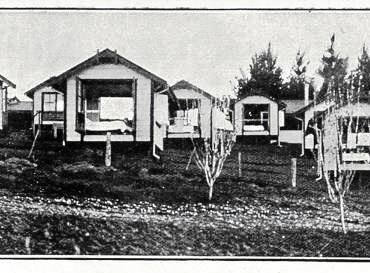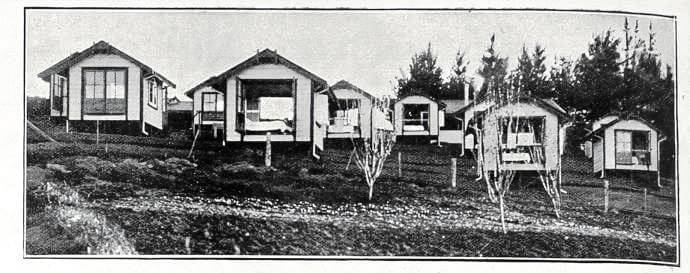
Open air quarters Cambridge sanitorium
‘The Captain of all these men of death’ – the dreaded tuberculosis – every so often visited the Te Awamutu district. The unflagging efforts of Isabel Pope in February 1911 could not save her husband William from it, nor was Donald Matheson later in that year any match for it.
In 1906 Isabel had resigned her Pirongia Postmistress position ahead of her forthcoming marriage. She had been in charge of the post office for many years and was appreciated for her courteous manner. The wedding was a popular one, William Pope also being liked and respected in the district. The Popes settled in Pirongia but the decimating disease, which was then commonly called consumption because it appeared to consume the affected person through weight loss and wasting, took hold of him. For a long time he required the utmost care and attention which he received from his attentive wife but five years after they married William died. He was buried in Pirongia cemetery.
In August of that year Donald Matheson, 41, was compelled to stop work at the Te Awamutu Bank of New Zealand where for the past five years he had been employed as an accountant. He suffered from a throat complaint and hoped that a three-month furlough would restore him to health. Donald had been in the employ of the BNZ since his arrival from Scotland 14 years previously. He had married Merelina Maude, 22, in 1908 when he was 37 but they were only to enjoy three years together. Donald’s death cut short what might have been a bright and promising life. He was buried in St John’s cemetery.
The first open air sanatorium for tuberculosis sufferers in New Zealand, Te Waikato, had been opened near Cambridge in 1903. It was thought the climate at Cambridge was drier than other parts of the North Island. The sanatorium was greatly needed, and many saw it as a lifeline. Methods for treating TB in the early 1900s included fresh air, good food and sometimes surgery; although an opinion from London stated that sanatoria were usually governed by medical men who did not themselves know how to breathe.
By 1912 fear-driven misinformation about the Cambridge sanatorium was discussed in parliament after the impression had got abroad that the inmates walked about the town and mixed with others. This had the effect of keeping people away from Cambridge.
The sanatorium, protested Mr Young, MP for Waikato, was not the ‘Cambridge Sanatorium’ and was not in the town of Cambridge.
The institution was ‘Te Waikato Sanatorium,’ and it was at Maungakawa, seven miles out of Cambridge away up on the hills.
“The Captain of all these men of death,” wrote John Bunyan in 1680, “that came against him to take him away, was the Consumption, for it was that that brought him down to the grave.”

Open air quarters Cambridge sanitorium








